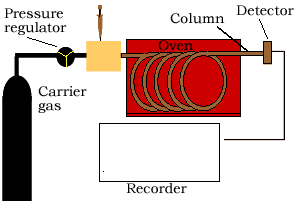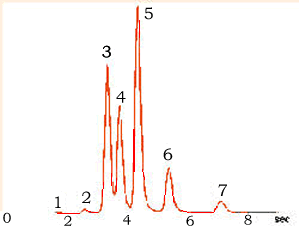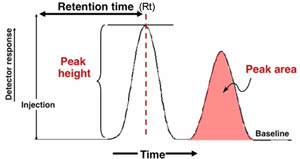Instrumental analysis
Gas-Liquid Chromatography (GLC)
In this technique an inert gas, such as helium or nitrogen, acts as the mobile phase. It is very sensitive, capable of detecting 10-12 grams of a compound. Its uses are limited to detecting compounds that can be readily vapourised without decomposing. Compounds with molar masses of between 2 (hydrogen) and 800 are commonly analysed.
.The animated video on the right explains the working of gas-liquid chromatography.
Sourced from https://www.youtube.com/watch?v=iX25exzwKhI\ at 9.30 am 25/09/20
Minute quantities of very potent chemicals can be detected which makes GLC ideal in the detection of performance-enhancing drugs used by athletes.
GLC is a very sensitive and can detect minute amounts of substance in the 2-3 ppb concentration range.

The instrumentation of GLC is slightly different to that of HPLC in that the injection port, column and detector are preheated to a specified temperature. The sample is quickly vapourised and carried by the gaseous mobile phase through the column.
The basic components of GLC
include:
- carrier gas cylinder with pressure regulator;
- an injection port for introducing the sample:
- the column;
- the detector;
- the recorder.
The column is a 2-3 m long loop of glass with an internal diameter of 4 mm. The column is packed with a porous solid coated with a high boiling point liquid and the components of the sample continuously pass into and out of solution with the stationary phase. How fast a particular compound travels through the column depends on how much of its time is spent moving with the gas and how much time it spends adsorbed to the stationary phase, the liquid.

A typical gas chromatogram is shown on the right. Absorbance (concentration) is plotted against retention time. The time it takes for a compound to emerge from the column is known as the retention time. Different compounds have different retention times. For a particular compound, the retention time will vary depending on:
-
its boiling point. A compound which boils at a relatively low temperature will spend most of its time in the gas phase and be carried quickly by the mobile phase, whereas a compound with a high boiling point temperature will spend a great deal of time condensed as a liquid at the start of the column and so will have a longer retention time.
-
its solubility in the liquid phase. The more soluble a compound is in the liquid phase, the less time it will spend being carried along by the gas, hence high retention times.
-
the temperature of the column. A higher temperature means all molecules in the sample have a greater average kinetic energy the forces of attraction of the liquid no longer hold them. A high column temperature shortens retention times for every molecule in the sample.
The amount of each compound can be found by measuring the area under each peak and comparing it to standards for each compound. Standard solutions are used to construct a calibration curve which is then used to determine the concentration of each compound.
Pure samples are also run through the column and their retention times measured and used later on to identify compounds in the sample being analysed.

Data that can be derived from a typical chromatogram include both qualitative, such as retention time, and quantitative, such as the area under each peak which corresponds to the relative amount of the compound.
Retention time is used to simply identify a compound. A mass spectrometer is sometimes used to confirm the presence of a compound rather than rely solely on the Rt value.
